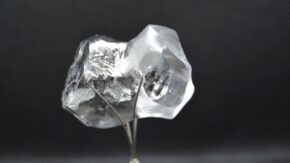It’s almost quaint to think back to some retailers’ initial reactions to synthetic diamonds. Fast forward to today, and many report an almost even split between mined and lab-grown when it comes to selling loose stones for bridal.
But the conversation has also shifted to the very real concerns of lab-grown’s plummeting prices and its oversaturation of the market. As a result, retailers walk a fine line between meeting customer demand and buying merchandise that’s losing value.
Client appeal
Successful retailers are always attuned to the pulse of the market. Purchasing a larger synthetic stone at a substantially lower retail price than a natural diamond is an attractive option for customers with limited budgets, as well as those who have more discretionary income.
“It’s a no-brainer. Customers really are excited that they can get a bigger stone,” says Joy Thollot, who cofounded Thollot & Co. Jewelers in Thornton, Colorado, with her husband Troy. “Fewer and fewer people think in terms of resale, especially the younger engaged couple.”
In her recent loose-stone unit sales, lab-grown has outnumbered mined two to one. The average lab-created center diamond is 2 to 2.50 carats, a size she says has been “growing by percentage” since the beginning of the year.
“Lab-grown took off like wildfire about a year and a half ago,” affirms Michael Littman, co-owner of Gary Michaels Fine Jewelers in Manalapan, New Jersey. “Even customers who might not be considered lab-grown buyers are asking for them.” These stones account for half his store’s loose-diamond bridal sales by unit, and that’s without his promoting them. He’s even sold a 15-carat lab-grown.
At Erik Runyan Jewelers in Vancouver, Washington, “almost 80% of our unit sales in the accessory area — including earrings, studs and pendants — are lab-grown,” reports owner Erik Runyan. In loose stones for bridal, the ratio of mined to lab-grown unit sales is approximately 50-50. He attributes these figures to both the savings and the “size difference” that lab-grown offers.
Going the memo route
Even as lab-grown sales increase, retailers are not stocking them for inventory the way they generally do with mined diamonds; they are largely purchasing on memo. Describing herself as an “early joiner” of the lab-grown segment, Thollot realized that “if we invested in it and the prices dropped, we would be upside down very quickly.” When synthetics first came on the market, her suppliers readily agreed to memo terms, she recalls. While she’s since changed vendors, she still buys her lab-grown on memo only.
Her one exception to this rule is De Beers’ Lightbox brand. “Their prices are so low. But more importantly, it is a brand that is promoted on the market,” she explains. “I did buy some lab-grown for stock early on to have them,” relates Runyan. “But my thinking has evolved; I’m wary of purchasing a product [when] I can’t be sure of its value. It creates a lot of angst to own something that will retail for less than what I paid for it.” As he notes, this is “not a good or sustainable business plan.”
Littman buys on memo for “almost 99%-plus” of his lab-grown, a practice he has followed since the beginning. “We haven’t invested in them as stock, because we still can get lab-grown that meets our exacting standards [via memo].”
A question of value
To some extent, memo can shelter retailers from synthetic stones’ falling prices. But with consumers expecting to pay less, it can be hard to compete with other jewelers.
“The visibility of loose lab-diamond pricing on well-known websites is setting prices for our clients, and I need to make sure I can stay competitive,” says Thollot. The only way to do this and still make a profit, she explains, is to work with suppliers that are willing to accept the latest market price as payment, since it may well be lower than the original memo price by the time the goods sell.
Store owners also voice concern for their clients. “I’m bluntly honest with my customer that I can only offer a trade-in for what the lab-grown is worth at the time of purchase, unlike a mined diamond they buy now and sell in the future,” says Runyan.
Even with the supply of lab-grown expanding rapidly, the robust demand should be keeping prices steadier than they are in practice, Littman argues. “Prices don’t have to drop so precipitously. Customers are buying at high levels. It almost feels like a race to the bottom.”
This article is from the July-August 2023 issue of Rapaport Magazine. View other articles here.
Image: (Shutterstock)



